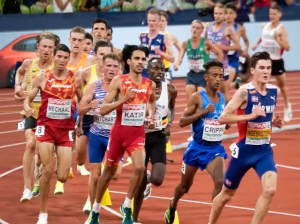What is the Norwegian method?
This style of training is also sometimes called the Norwegian double-threshold method because athletes complete two lactate threshold training sessions on a single day, usually two times per week. This permits threshold training at about 20% of weekly volume while doing relatively high mileage.
These insights come from a 2024 scientific paper published in the Scientific Journal of Sport and Performance. The paper is a literature review, which means that the authors try to discover and identify all existing scientific research on a certain topic. My goal is to deliver the findings to you so you can use the principles in your training.
The lead author is Bence Kelemen from the Hungarian University of Sport Science. Bence is a fine athlete himself, as seen in his World Athletics profile. And, yes, in Hungary, they have entire universities devoted to sport science. I like the concept, and as an aside, it highlights the different culture of sports and academics that developed in the countries that were part of the former Eastern Bloc.
The paper reviews the training of 12 Norwegian distance runners who achieved world-class performances from 1979 to today. The names include Grete Waitz, Ingrid Kristiansen, Marius Bakken, and Jakob Ingebrigtsen. While Waitz and Kristiansen are best known for their marathon performances, the training was analyzed for when they and the other athletes were in preparation for race distances from 1500 m to 10,000 m.
Historically, Norway has produced many high level performances, even though it is a small country of under 6 million population. When success is beyond what you would expect given its population, it’s time to take notice. Without following blindly, we can gain insight from a well-established training system, particularly when there is a sound basis in sport science.

We’re going to learn from these athletes who have had success on the world stage. While most cannot duplicate the training of world-class athletes, here are some training principles that all runners can use.
Contributors to distance running performance
Aerobic energy production is dominant for race distances from 1500 m to 10,000 m and beyond. Bence Kelemen and his colleagues highlight the similar training used for this range of distance. Of course, you need to train the pace of your target race more specifically in the pre-competition and competition season, but because these events are all highly aerobic, the bulk of training is in the same physiogical category.
In the endurance domain, three main physiological abilities contribute to performance. These are VO2 max, running economy, and lactate threshold. Lactate threshold is also commonly associated with the term anaerobic threshold. Scientists don’t regard these terms as exactly the same, but for practical purposes, they occupy the same space in training program design.
I am going to show you how the Norwegian method fits within this framework through its emphasis on lactate threshold training.
A good training program develops the following…
VO2 max
VO2 max is the darling physiological metric of aerobic-oriented exercise physiologists. It refers to the maximum rate at which you can take in oxygen and deliver it to your working muscles where it can be used for energy production.
All elite endurance athletes have a high VO2 max, it won’t tell you who is best among a group of elite athletes. In other words, VO2 max is necessary for distance running success, but not sufficient on its own for optimal performance.
For a deeper dive into VO2 max, including sample workouts, check out this article.
In addition to having a high VO2 max, you want to be able to run fast at that level of oxygen consumption (velocity at; vVO2 max) and maintain a high percentage of that VO2 max as long as possible (%VO2 max).
Running economy
A high VO2 max is great, but it doesn’t mean anything if you can’t run fast at a given level of oxygen consumption. If you can run faster at the same level of oxygen consumption, you have improved your running economy. As well, if you can use a lower level of oxygen consumption at the same running speed, you have improved your running economy.
I discuss how to improve running economy in this article.
Lactate threshold / anaerobic threshold
There are actually two lactate thesholds. The first is when blood lactate concentration rises above baseline levels (LT1). The second one is when blood lactate continues to rise because elimination cannot keep up with production (LT2).
It is common to refer to LT2 as “lactate threshold”, “anaerobic threshold”, or simply “threshold”. That’s the term I’ll use in this article.
It is crucial to focus on lactate threshold because it is highly associated with fatigue and performance.
Benefits of the Norwegian method
The Norwegian method focuses on lactate threshold training. More carefully put, the key workouts are crafted to emphasize time running at a physiological intensity below lactate threshold (specifically LT2), yet above LT1.
Operationally, scientists have called this lactate-guided threshold interval training. Intensity is guided according to (internal) physiological intensity rather than (external) absolute running speed. The goal is to create the ideal training stimulus for cellular and metabolic improvements that are important for distance running performance.

Principle 1: Know your training intensities
I adapted the following table of intensities from a 2013 scientific paper from Norwegian researcher Leif Tjelta.
* Slower runners should modify target paces. Example: zone 2 can be maintained for about 60 minutes. This is half marathon pace for an elite runner but might be 10k pace for a slower athlete.
| Zone | Pace * | Lactate (mmol/L) | HR (% max) | Desired improvement |
|---|---|---|---|---|
| 1 | Easy – moderate | 0.7-2.0 | 62-82 | Recovery, running economy |
| 2 | Half marathon | 2.0-4.0 | 82-92 | Lactate threshold |
| 3 | 3k – 5k – 10k | 4.0-6.0 | 92-97 | VO2 max |
| 4 | 800m – 1500m | > 6.0 | > 97 | Anaerobic capacity |
| 5 | Sprint | – | – | Speed |
Principle 2: Maintain high volume at low intensity
The Norwegian training method seeks maximum adaptation for the least stress. Overall volume is high, but 80% of that volume is performed at low intensities.
This stimulates biogenesis of mitochondria (known by the cliché term “powerhouse of the cell”) and capillarization in the slow twitch muscle fibers that are predominantly used in low intensity exercise.
Mitocondrial proliferation happens via two signalling pathways: calcium (associated with high-volume training) and AMPK (associated with high-intensity training).
Because the adaptive potential of the calcium pathway may be greater, it may be best to emphasize that with high-volume low-intensity training.
The AMPK pathway may be optimized with only a small volume of high-intensity work, so any further volume would lead to too much fatigue. This would show up as an excessive inflammatory response and slow autonomic recovery. These aspects would inhibit your ability to adapt to training, since they represent a significant stress to the body that requires significant recovery.
Okay, that’s it for physiology today!
Principle 3: Focus on lactate threshold training
The running speed at which lactate accumulates is highly related to endurance performance.
According to esteemed running researcher Veronique Billat lacate threshold pace can be maintained for about 1 hour. This might correspond to half-marathon pace for elite athletes, but if your 10k time is about 1 hour, you should use that pace instead.
Lactate threshold training leads to adaptations that lower lacate at a given speed and increase speed at a given level of lactate. Training at or below lactate threshold improves your ability to clear lactate. You will still produce lots of lactate when running fast, but you will be able to clear it faster, which limits accumulation, and lets you run faster and longer.
With lactate-guided training it is important to not exceed the lactate threshold. Why? You want the benefits without the added fatigue.
According to a paper led by Swedish researcher Bertil Sjödin, runners who did not allow lactate to drift upward during training had a greater performance improvement than those who did allow lactate to rise.
Research led by British researcher Mark Burnley showed that exercise just above lactate threshold showed global and peripheral fatigue 4-5 times larger than exercise just below lactate threshold.
Let that sink in….
If you don’t carefully target the right intensity, you run the risk of much greater fatigue for very little benefit. It should be mentioned, however, that some work at higher intensities is still needed and appropriate, according to another paper by Spanish researcher Arturo Casado and his colleagues.
The Norwegian training method explained (top 7 tips)
- High volume
- 80% low intensity – 20% high intensity
- Monitor intensity relative to lactate threshold
- Design of lactate threshold intervals
- Norwegian double-threshold method
- The optimal amount of high intensity training
- Periodization: base training vs. competition period
1. High volume
The 12 Norwegian athletes ran on average 75 to 112 miles (120 to 180 km) per week. Higher mileage was done in the base training period and lower mileage was done in the competition period.
2. 80% low intensity – 20% high intensity
Most like-minded athletes do 75% to 80% of their training volume at low intensity. This would be at minimal lactate levels (below LT1), a heart rate of about 62% to 82% of maximum, and a rating of perceived exertion (RPE) of 9-12 on a scale of 6-20.
High-intensity training is usually includes 2-4 lactate threshold sessions per week. In the base phase, would session per week would be at faster paces above the lactate threshold.
3. Monitor intensity relative to lactate threshold
The athletes take care to avoid exceeding the lactate threshold during threshold workouts. An appropriate intensity is found between 82% and 90% of maximum heart rate. You can easily monitor this with your running watch. Just remember to ensure that your maximum heart rate value is properly set.
A more exact method of determining intensity requires a lactate meter. Lactate measurements can be made every 1-3 intervals to ensure that the desired intensity is not exceeded. This is one of the practical benefits of doing threshold training in the form of intervals rather than continuous running.
Ever since I first read Marius Bakken on lactate threshold training, I have remembered his exhortation…“you need to KNOW!“. He stresses the importance of correctly understanding your individual physiological intensity thresholds to target specific training benefits and avoid unnecessary fatigue.
I describe the lactate threshold extensively in this article.
4. Design of lactate threshold intervals
There is a really clever benefit to doing lactate threshold training in the form of intervals.
With intervals, you can manipulate the speed and duration of the work and rest intervals to dial in the right physiological intensity zone. You need to do longer intervals at a slightly lower intensity because there is more time for lactate to rise. Shorter intervals can be done at a slightly higher intensity because there is not enough time for lactate to rise too high and it will decrease during the rest periods that come more frequently.
Shorter intervals therefore allow you to do faster absolute running speeds while still staying within the appropriate physiological intensity range. In the figure below you can see the difference in lactate kinetics between shorter and longer intervals.
The short interval (400 m) workout is targeting a lactate level of 3.5 mmol/L, while the long interval (2000 m) workout is targeting a lactate level of 2.5 mmol/L. Real-world data is rarely this clean, but you get the point.

5. Norwegian double threshold method
The athletes did two to four lacate threshold training sessions per week. Each threshold session would allow the accumulation of 5 to 7.5 mi (8 to 12 km) of threshold training.
The best way to put this all together is to do two threshold training sessions per day on two days during the week. This permits a hard day – easy day schedule, and gives opportunity for a faster session and/or a longer run during the week.
Most runners won’t be able to maintain this sort of schedule, but this would only be necessary at a higher weekly mileage. For runners doing 60 mi (100 km) per week, 20% volume devoted to threshold would be about 12 mi (20 km), which is definitely possible on just two workouts.
It is crucial to understand that two fast training sessions on the same day would simply not be possible at speeds above lactate threshold. I am not sure I have ever heard of this being done. It would be recipe for quick overuse injury and certain breakdown.
6. The optimal amount of high intensity training
Once per week (perhaps twice in the competition period) the athletes might perform a higher intensity session at near-maximum heart rate. This would include running at 800 to 1500 m race pace (zone 4), or sprints (zone 5)
A commonly-mentioned zone 4 workout for the base phase is 20*200 m hills with 70 sec recovery (jog back down). This would require the intensity of 800 to 1500 m race pace. Base phase training for zone 5 might be sprints of 60 to 100 m.
You don’t need to measure heart rate during such workouts because it would be near maximum all the time and there would be little to manage. It is just mentioned to give a sense of the intenstity. You might monitor heart rate during the recoveries, though.
Longer intervals at 92 to 97% of heart rate (zone 3) tend to be avoided by the athletes during the base period, reflecting a polarized model during this training phase.
7. Periodization: base training versus competition period
As said above, in the base period, most training is done in zones 1 and 2, both below the lactate threshold. One training session per week may be done in zones 4 or 5.
During the competition period, the athletes tend to de-emphasize threshold workouts and increase the number of sessions at specific race pace. For example, they might decrease threshold training from 4 to 2 sessions per week and adopt more zone 3 and zone 4 workouts, which would cover race paces from 800 m to 10,000 m.
During the competition season, the Ingebrigtsen brothers are known to do a low-high intensity volume ratio of 75:25 for a non-race week, and 80:20 for a race week.
Sample workouts
Zone 2: Threshold intervals
- Base period: up to 4 workouts per week
- Competition period: as low as 2 workouts per week
Morning: longer intervals (~ half-marathon pace)
- 5*6 min @ 2.5 mmol/L with 1 min recovery
- 3*10 min @ 2.5 mmol/L with 1 min recovery
- 5*2000 m @ 2.5 mmol/L with 1 min recovery
Evening: shorter intervals (~ 5000 to 10,000 m pace)
- 10*1000 m @ 3.5 mmol/L with 1 min recovery
- 25*400 m @ 3.5 mmol/L with 30 sec recovery
- Series of 45 sec intervals with 15 sec recovery
If two fast workouts are done on one day, there should be at least 5 hours in between. If you are only doing one threshold session per day (most non-professional runners), then you could choose any of the workouts above.
Summary
The Norwegian method of lactate threshold training emphasizes a high-volume of running with a high to low intensity distribution of 80:20. In the base phase, up to 4 lactate threshold training sessions are done per week, done in double-threshold style with two such workouts per day. One additional session may be done at higher intensity each week.
If you are a regular runner doing a more moderate level of mileage, you would do 2 threshold workouts per week – only one per day, and each workout must be followed by at least one easy day. Minimizing fatigue by avoiding exessive volume above threshold will enhance your ability to adapt.
When training in the competition phase, some lacate threshold training sessions may be dropped and replaced by race-specific training in zones 3-4. These zones include race paces from 800m to 10,000m, which brings about high lactate values. This sharpens the athletes for racing.
I think the strength of this training framework is that it provides the greatest benefit for the least amount of fatigue. And it’s nice to know that high quality training doesn’t always need to hurt – staying below threshold is enjoyable while still being a good challenge.
Let me know what you think!




